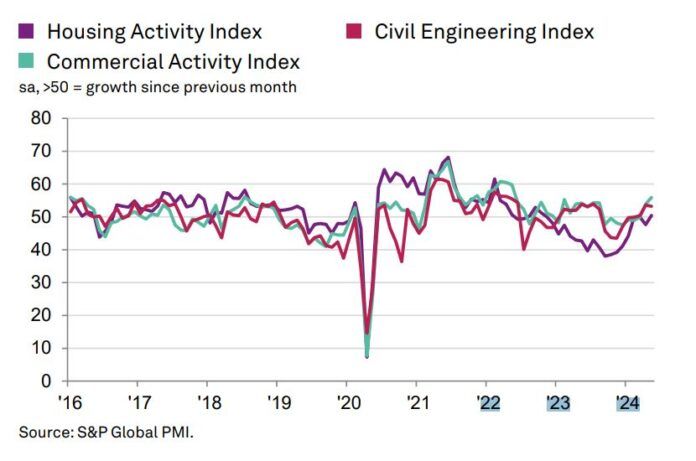Growth in the UK construction sector gained momentum during May, with activity and new business increasing at sharper rates than in April.
The latest report from S&P Global found that rising workloads prompted renewed expansions in purchasing activity and employment, while business confidence also strengthened. Supply-chain conditions also continued to improve amid reports of good stock availability at vendors.
This contributed to the pace of input cost inflation slowing to a marginal pace.
Index breakdown
The headline UK Construction Purchasing Managers’ Index (PMI) posted above the 50.0 no-change mark for the third month running in May to signal a sustained expansion in activity midway through the second quarter of the year.
Moreover, the index rose to 54.7 from 53.0 in April, pointing to a marked increase in activity that was the fastest for two years.
Additionally, for the first time since May 2022, all three monitored categories saw activity increase during the month as housing activity returned to growth.
The expansion in activity on residential projects was only marginal, however. The sharpest increase in activity was seen in the commercial category where the rate of growth accelerated to a two-year high.
Meanwhile, civil engineering activity rose at a solid, but slightly softer pace. According to respondents to the survey which compiled the report, the latest increase in total construction activity reflected sustained growth of new orders. New business rose for the fourth consecutive month, and at a solid pace that was the fastest for a year as demand conditions improved. In particular, firms linked higher new orders to the winning of new contracts and the commencement of previously delayed projects. With new order growth sustained midway through the second quarter, construction firms increased employment for the first time in five months. Although only modest, the pace of job creation was the sharpest since last September.
Costs
A renewed increase in purchasing activity was also registered in May, again linked to improving workloads. The rise in input buying ended an eight-month sequence of decline. Where companies purchased inputs, they once again experienced an improvement in vendor performance amid reports that stock holdings at suppliers were healthy.
Furthermore, lead times shortened to the greatest extent in seven months. With supply-chain conditions improving, companies noted only a marginal increase in input costs during May, with the rate of inflation the softest in the current five-month sequence of rising input prices. Construction firms also signalled a marked improvement in the availability of sub-contractors in May, despite the largest expansion in their usage since April 2022. The rates charged by subcontractors increased solidly, albeit at a pace that was weaker than the series average.
Outlook
Further increases in new orders, in some cases linked to planned marketing campaigns, are set to support continued growth of construction activity over the next 12 months. Companies also hoped for an improvement in economic conditions and reduction in interest rates. Business confidence increased to a three-month high in May.
Industry reaction
An increase in construction PMIs should provide developers with further optimism. However, developers will now be turning their attention to party manifestos and hoping to see proposals and regulation reforms to streamline planning processes, says Terry Woodley, MD of development finance at Shawbrook:
“A third consecutive rise in construction output should provide developers with further optimism.
“However, market volatility and the possibility of predicted interest rate cuts being pushed back to later in the year mean lenders have had to raise rates in some areas, an additional cost for developers to factor in, alongside the rising costs of materials and labour.
“Many developers will now be turning their attention towards party manifestos ahead of the upcoming election, and will be hoping to see proposals and regulation reforms introduced to streamline planning processes and unlock the UK’s housebuilding potential. Developers are also hoping for additional support for first time buyers – with 86% hoping that the next government introduces further measures to assist buyers and ramp up building, according to Shawbrook’s latest research. Until then, developers should consider partnering with a specialist lender to secure the best rates and future-proof their businesses against any further challenges.”
Atul Kariya, head of construction and real estate at MHA, commented: “The rise in construction PMI data to 54.7, the fastest in two years, is very positive news for the sector. After months in the doldrums, there are definitely green shoots visible, which should continue throughout the summer months, as it typically does as construction output increases.
“The significant increase in the commercial category shows that the industry is now on a firmer footing than it has been for a considerable time, particularly given the slightly more positive economic indicators and the potential for a cut in interest rates later in the summer. Our clients are telling us that things are slowly, steadily and cautiously starting to fall into place after a period of uncertainty, which will enable them to start making longer-term decisions.
“While the announcement of the election has come as welcome news as it hopefully will provide some stability after July 4 it is surprising that with housing being one of the major components of the UK economy, there has so far been very little debate about how any of the parties are planning to deal with some fundamental challenges in the sector – not least the significant shortfall in trained, younger workers.”




